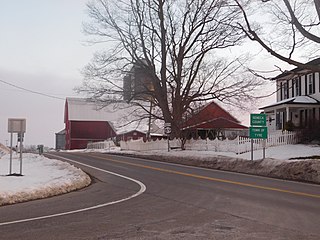
Seneca County is located in the U.S. state of New York. As of the 2020 census, the population was 33,814. The county seat is Waterloo. It became a one county in 1822, which currently remains in effect and uses one locations as county seats although the majority of Seneca County administrative offices are located in Waterloo. Therefore, most political sources list only Waterloo as the county seat. The county's name comes from the Seneca Nation of the Haudenosaunee (Iroquois), who occupied part of the region.

Conquest is a town in Cayuga County, New York, United States. The population was 1,819 at the 2010 census. The name was chosen to mark the victory of those who wished to form the town. Conquest is on the western border of Cayuga County and is west of Syracuse.
Millport is a village in Chemung County, New York, United States. The population was 312 at the 2010 census. The name comes from its former status as a canal port.

Seneca Knolls is a hamlet in Onondaga County, New York, United States. The population was 2,011 at the 2010 census.
Burdett is a village in Schuyler County, New York, United States. The population was 357 at the 2000 census.
Covert is a town in Seneca County, New York, United States. The population was 2,154 at the 2010 census.
Interlaken is a village in Seneca County, New York, United States. The population was 602 at the 2010 census. The name is related to the village's position between two lakes.
Romulus is a town in Seneca County, New York, United States. The population was 4,316 at the 2010 census. The town is named after the mythical founder of Rome, Romulus, a name assigned by a clerk with an interest in the classics. It is located in the central part of the county, northwest of Ithaca, New York.

Tyre is a town in Seneca County, New York, United States. The population was 981 at the 2010 census. The town is named after the Lebanese city of Tyre.

Clyde is a village in Wayne County, New York, United States. The population was 2,093 at the 2010 census. It was named after the River Clyde, in Scotland, and the village sits on the Clyde River, a tributary of the Seneca River.

Huron is a town in Wayne County, New York, United States. The population was 2,118 at the 2010 census. The town is named after the Huron Indians.

Dresden is a village in Yates County, New York, United States. The population was 308 at the 2010 census. The village was named after Dresden in Germany.

Dundee is a village in Yates County, New York, United States. The population was 1,725 at the 2010 census. The name was taken from Dundee, the city in Scotland with a population of 148,260.
Lodi is a town in Seneca County, New York, United States. The population was 1,550 at the 2010 census.
Ovid is a village in Seneca County, New York, United States. The population was 602 at the 2010 census. The town was named by a clerk interested in the classics.
Ovid is a town in Seneca County, New York, United States. The population was 2,311 at the 2010 census. The town is named after the Roman poet Ovid, a name assigned by a clerk interested in the classics.

Seneca Falls is a hamlet and census-designated place in Seneca County, New York, United States. The population was 6,681 at the 2010 census. The hamlet is in the Town of Seneca Falls, east of Geneva. It was an incorporated village from 1831 to 2011.

Waterloo is a village and primary county seat of Seneca County, New York, United States. The population was 5,171 at the 2010 census and is now the most populated village in Seneca County. The village is named after Waterloo, Belgium, where Napoleon was defeated. It is the primary county seat of Seneca County, with the other being Ovid as part of a two-shire system established in 1822. Most of the county administrative offices are located in the village. Therefore, many political sources only list Waterloo as the county seat.

Waterloo is a town in Seneca County, New York, United States. The population was 7,642 at the 2010 census. The town and its major community are named after Waterloo, Belgium, where Napoleon was defeated.
Romulus is a hamlet located in the Town of Romulus, Seneca County, New York, United States on the border with the Town of Varick. The population was 409 at the 2010 census.












